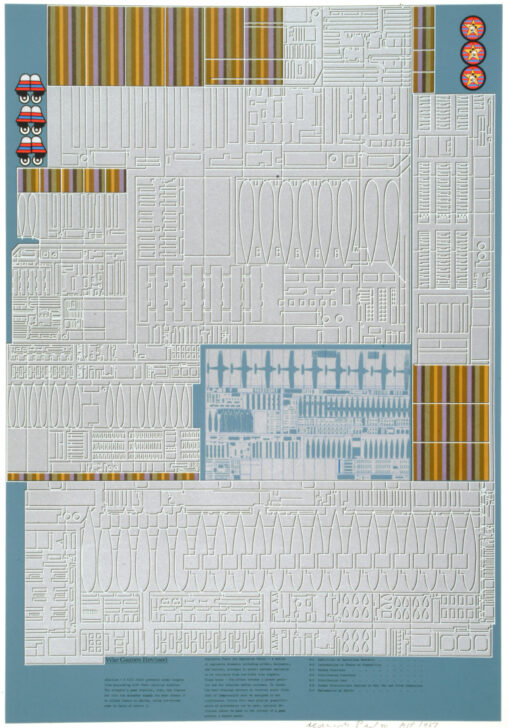War Games Revised
Sir Eduardo Paolozzi ; Kelpra Studio Ltd, London

Description
Subject Matter:
As one of the founders of the Independent Group, Paolozzi was an early British Pop artist. This series of ten prints came after his travels in California, where he visited tourist sites like Disneyland, Frederick's of Hollywood, and Paramount Studios, as well as centers of technology: UC Computer Center, Standord's Linear Accelerator center, Douglas Aircraft Company and the GM Assembly Plant in Hayward. The combination of imagery from popular culture, here Mickey Mouse, and the technological imagery of dot matrixes and circuit boards creates a stage in which art and science can be in dialogue. Not only does the text and the title refer to war strategy but the imagery at the center, with the shapes of bombs and planes, point to this reading. However, this work is clearly a parody of war games because the star of Mickey Mouse is included.
Physical Description:
This print has a teal-blue background with a series of patterned-panels overtop. One of these panel types has vertical stripes in dark and light olive, orange, and purple. Another set of panels are grey with white outlines of shapes that resemble mechanical parts. At the center of the print, there is a negative in grey of a series of parts and images of planes. On the upper left, there are three designs in white, red, blue and black. On the right, there are three black rondels, with blue and red stripes and a yellow star at the center. On each star is an image of Mickey Mouse. At the bottom of the print, there are three columns of text that read: column left, "War Games Revisited / Abortion - A kill which prevents enemy targets / from proceeding with their tacitcal mission. ' The attacker's game theorist, then, has figured / out that the attacker stands the best chance if / he allows chance to decide, using two-to-one / odds in favor of sector 2."; center column, "Explosive Train (or Explosive Chain) - A series / of explosive elements including primer, detonator, / and booster, arranged to permit warhead explosion / to be initiated from low-level fuse signals. / Fixed Error - The affect between the present porsit- / ion and the observed median outcomes. To choose / the best strategy mixture an interval scale (like / that of temperature) must be assigned to our / preferences. Unless this more precise quantific- / ation of preferences can be made, rational de- / cisions cannot be made in the context of a game / without a naddle point."; right column, "6-1- Definitions of Operations Research . . . . . . . / 6-2 Introduction to Theory of Probability . . . . . . / 6-3 Random Functions . . .. . .. . . . . . . / 6-4 Distribution Functions . . . . . . . . . . / 6-5 Distribution Laws . . . . . . . . . . . / 6-6 Normal Distributions Applied in One, Two and Three Dimension / 6-7 Mathematics of Battle . . . . . . . . . . ". The print is signed and dated in pencil (l.r.) Eduardo Paolozzi A/P 1967".
Usage Rights:
If you are interested in using an image for a publication, please visit https://umma.umich.edu/request-image/ for more information and to fill out the online Image Rights and Reproductions Request Form.